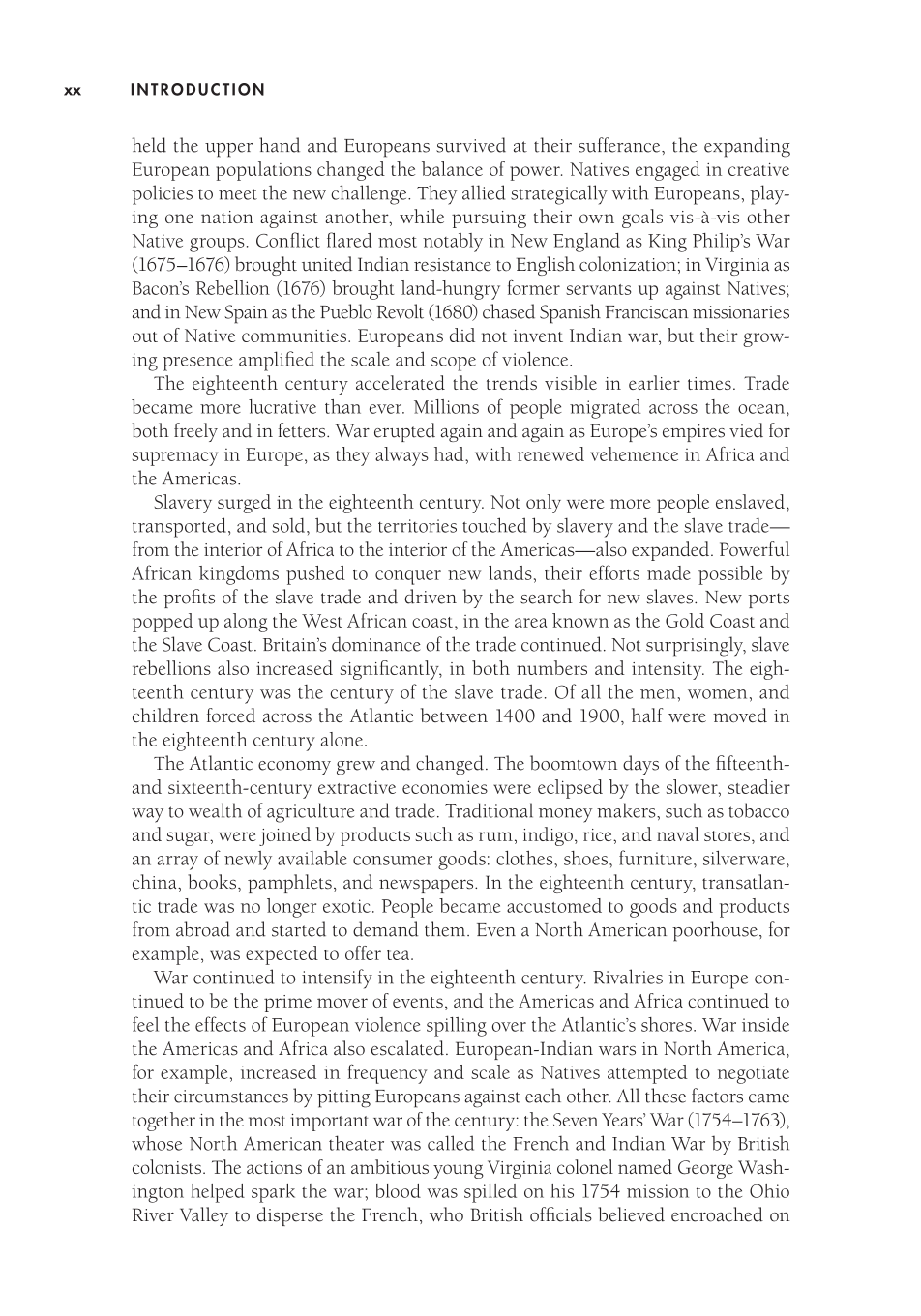xxI ntroduction
held the upper hand and Europeans survived at their sufferance, the expanding
European populations changed the balance of power. Natives engaged in creative
policies to meet the new challenge. They allied strategically with Europeans, play-
ing one nation against another, while pursuing their own goals vis-à-vis other
Native groups. Conflict flared most notably in New England as King Philip’s War
(1675–1676) brought united Indian resistance to English colonization; in Virginia as
Bacon’s Rebellion (1676) brought land-hungry former servants up against Natives;
and in New Spain as the Pueblo Revolt (1680) chased Spanish Franciscan missionaries
out of Native communities. Europeans did not invent Indian war, but their grow-
ing presence amplified the scale and scope of violence.
The eighteenth century accelerated the trends visible in earlier times. Trade
became more lucrative than ever. Millions of people migrated across the ocean,
both freely and in fetters. War erupted again and again as Europe’s empires vied for
supremacy in Europe, as they always had, with renewed vehemence in Africa and
the Amer i cas.
Slavery surged in the eighteenth century. Not only were more people enslaved,
transported, and sold, but the territories touched by slavery and the slave trade—
from the interior of Africa to the interior of the Amer i cas—also expanded. Powerful
African kingdoms pushed to conquer new lands, their efforts made possible by
the profits of the slave trade and driven by the search for new slaves. New ports
popped up along the West African coast, in the area known as the Gold Coast and
the Slave Coast. Britain’s dominance of the trade continued. Not surprisingly, slave
rebellions also increased significantly, in both numbers and intensity. The eigh
teenth century was the century of the slave trade. Of all the men, women, and
children forced across the Atlantic between 1400 and 1900, half were moved in
the eighteenth century alone.
The Atlantic economy grew and changed. The boomtown days of the fifteenth-
and sixteenth-century extractive economies were eclipsed by the slower, steadier
way to wealth of agriculture and trade. Traditional money makers, such as tobacco
and sugar, were joined by products such as rum, indigo, rice, and naval stores, and
an array of newly available consumer goods: clothes, shoes, furniture, silverware,
china, books, pamphlets, and newspapers. In the eighteenth century, transatlan-
tic trade was no longer exotic. People became accustomed to goods and products
from abroad and started to demand them. Even a North American poorhouse, for
example, was expected to offer tea.
War continued to intensify in the eighteenth century. Rivalries in Europe con-
tinued to be the prime mover of events, and the Americas and Africa continued to
feel the effects of European violence spilling over the Atlantic’s shores. War inside
the Americas and Africa also escalated. European-Indian wars in North America,
for example, increased in frequency and scale as Natives attempted to negotiate
their circumstances by pitting Eu ro peans against each other. All these factors came
together in the most important war of the century: the Seven Years’ War (1754–1763),
whose North American theater was called the French and Indian War by British
colonists. The actions of an ambitious young Virginia col o nel named George Wash-
ington helped spark the war; blood was spilled on his 1754 mission to the Ohio
River Valley to disperse the French, who British officials believed encroached on

























































































































































































































































































































































































































































































































































































































































































































































































































